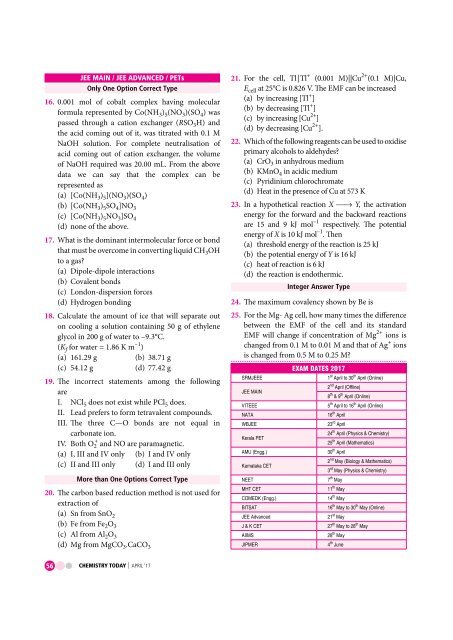Chemistry_Today_April_2017_vk_com_stopthepress
Create successful ePaper yourself
Turn your PDF publications into a flip-book with our unique Google optimized e-Paper software.
JEE MAIN / JEE ADVANCED / PETs<br />
Only One Option Correct Type<br />
16. 0.001 mol of cobalt <strong>com</strong>plex having molecular<br />
formula represented by Co(NH 3 ) 5 (NO 3 )(SO 4 ) was<br />
passed through a cation exchanger (RSO 3 H) and<br />
the acid <strong>com</strong>ing out of it, was titrated with 0.1 M<br />
NaOH solution. For <strong>com</strong>plete neutralisation of<br />
acid <strong>com</strong>ing out of cation exchanger, the volume<br />
of NaOH required was 20.00 mL. From the above<br />
data we can say that the <strong>com</strong>plex can be<br />
represented as<br />
(a) [Co(NH 3 ) 5 ](NO 3 )(SO 4 )<br />
(b) [Co(NH 3 ) 5 SO 4 ]NO 3<br />
(c) [Co(NH 3 ) 5 NO 3 ]SO 4<br />
(d) none of the above.<br />
17. What is the dominant intermolecular force or bond<br />
that must be over<strong>com</strong>e in converting liquid CH 3 OH<br />
to a gas?<br />
(a) Dipole-dipole interactions<br />
(b) Covalent bonds<br />
(c) London-dispersion forces<br />
(d) Hydrogen bonding<br />
18. Calculate the amount of ice that will separate out<br />
on cooling a solution containing 50 g of ethylene<br />
glycol in 200 g of water to –9.3°C.<br />
(K f for water = 1.86 K m –1 )<br />
(a) 161.29 g<br />
(b) 38.71 g<br />
(c) 54.12 g<br />
(d) 77.42 g<br />
19. The incorrect statements among the following<br />
are<br />
I. NCl 5 does not exist while PCl 5 does.<br />
II. Lead prefers to form tetravalent <strong>com</strong>pounds.<br />
III. The three C—O bonds are not equal in<br />
carbonate ion.<br />
IV. Both O + 2 and NO are paramagnetic.<br />
(a) I, III and IV only (b) I and IV only<br />
(c) II and III only (d) I and III only<br />
More than One Options Correct Type<br />
20. The carbon based reduction method is not used for<br />
extraction of<br />
(a) Sn from SnO 2<br />
(b) Fe from Fe 2 O 3<br />
(c) Al from Al 2 O 3<br />
(d) Mg from MgCO 3 .CaCO 3<br />
21. For the cell, Tl|Tl + (0.001 M)||Cu 2+ (0.1 M)|Cu,<br />
E cell at 25°C is 0.826 V. The EMF can be increased<br />
(a) by increasing [Tl + ]<br />
(b) by decreasing [Tl + ]<br />
(c) by increasing [Cu 2+ ]<br />
(d) by decreasing [Cu 2+ ].<br />
22. Which of the following reagents can be used to oxidise<br />
primary alcohols to aldehydes?<br />
(a) CrO 3 in anhydrous medium<br />
(b) KMnO 4 in acidic medium<br />
(c) Pyridinium chlorochromate<br />
(d) Heat in the presence of Cu at 573 K<br />
23. In a hypothetical reaction X → Y, the activation<br />
energy for the forward and the backward reactions<br />
are 15 and 9 kJ mol –1 respectively. The potential<br />
energy of X is 10 kJ mol –1 . Then<br />
(a) threshold energy of the reaction is 25 kJ<br />
(b) the potential energy of Y is 16 kJ<br />
(c) heat of reaction is 6 kJ<br />
(d) the reaction is endothermic.<br />
Integer Answer Type<br />
24. The maximum covalency shown by Be is<br />
25. For the Mg- Ag cell, how many times the difference<br />
between the EMF of the cell and its standard<br />
EMF will change if concentration of Mg 2+ ions is<br />
changed from 0.1 M to 0.01 M and that of Ag + ions<br />
is changed from 0.5 M to 0.25 M?<br />
SRMJEEE<br />
JEE MAIN<br />
VITEEE<br />
NATA<br />
WBJEE<br />
Kerala PET<br />
AMU (Engg.)<br />
Karnataka CET<br />
NEET<br />
MHT CET<br />
COMEDK (Engg.)<br />
BITSAT<br />
JEE Advanced<br />
J & K CET<br />
AIIMS<br />
JIPMER<br />
EXAM DATES <strong>2017</strong><br />
1 st <strong>April</strong> to 30 th <strong>April</strong> (Online)<br />
2 nd <strong>April</strong> (Offline)<br />
8 th & 9 th <strong>April</strong> (Online)<br />
5 th <strong>April</strong> to 16 th <strong>April</strong> (Online)<br />
16 th <strong>April</strong><br />
23 rd <strong>April</strong><br />
24 th <strong>April</strong> (Physics & <strong>Chemistry</strong>)<br />
25 th <strong>April</strong> (Mathematics)<br />
30 th <strong>April</strong><br />
2 nd May (Biology & Mathematics)<br />
3 rd May (Physics & <strong>Chemistry</strong>)<br />
7 th May<br />
11 th May<br />
14 th May<br />
16 th May to 30 th May (Online)<br />
21 st May<br />
27 th May to 28 th May<br />
28 th May<br />
4 th June<br />
56 CHEMISTRY TODAY | APRIL ‘17


